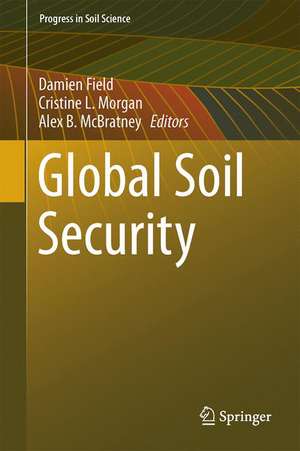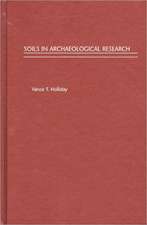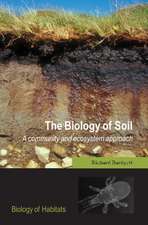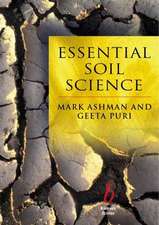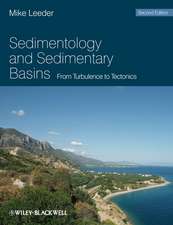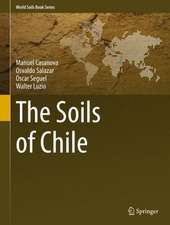Global Soil Security: Progress in Soil Science
Editat de Damien J. Field, Cristine L.S. Morgan, Alex B. McBratneyen Limba Engleză Hardback – 6 dec 2016
| Toate formatele și edițiile | Preț | Express |
|---|---|---|
| Paperback (1) | 849.21 lei 38-44 zile | |
| Springer International Publishing – 6 iul 2018 | 849.21 lei 38-44 zile | |
| Hardback (1) | 872.36 lei 38-44 zile | |
| Springer International Publishing – 6 dec 2016 | 872.36 lei 38-44 zile |
Preț: 872.36 lei
Preț vechi: 1147.84 lei
-24% Nou
Puncte Express: 1309
Preț estimativ în valută:
166.92€ • 181.89$ • 140.66£
166.92€ • 181.89$ • 140.66£
Carte tipărită la comandă
Livrare economică 19-25 aprilie
Preluare comenzi: 021 569.72.76
Specificații
ISBN-13: 9783319433936
ISBN-10: 3319433938
Pagini: 556
Ilustrații: XVIII, 469 p. 102 illus., 75 illus. in color.
Dimensiuni: 155 x 235 x 31 mm
Greutate: 1.05 kg
Ediția:1st ed. 2017
Editura: Springer International Publishing
Colecția Springer
Seria Progress in Soil Science
Locul publicării:Cham, Switzerland
ISBN-10: 3319433938
Pagini: 556
Ilustrații: XVIII, 469 p. 102 illus., 75 illus. in color.
Dimensiuni: 155 x 235 x 31 mm
Greutate: 1.05 kg
Ediția:1st ed. 2017
Editura: Springer International Publishing
Colecția Springer
Seria Progress in Soil Science
Locul publicării:Cham, Switzerland
Cuprins
Part I: Rationale for soil security.- Soil security – a rationale.- Soil security: dimensions.- Part II: Capability.- Soil capability: exploring the functional potentials of soils.- Distinguishing between capability and condition.- The value of soil capability in land surface modeling.- Soil capability for the United States now and into the future.- Quantifying soil capability: GlobalSoilMap.- Testing the links between soil security, sustainable land management practices and land evaluation.- Part III: Condition.- General concepts of valuing and caring for soil.- Soil health: challenges and opportunities.- Using soil survey to assess and predict soil condition and change.- Root-microbe interactions in response to soil conditions.- Securing our soil in intense monoculture cropping systems.- Soil organic carbon stocks and soil respiration in tropical secondary forests in southern Mexico.- Simulating impacts of bioenergy sorghum residue return on soil organic carbon and greenhouse gas emissions using the Daycent model.- Cover crop effects on soil carbon and nitrogen under bioenergy sorghum crops.- Part IV: Capital.- Energy, economics, climate change and soil security.- Understanding soils’ contribution to ecosystem services provision to inform farm system analysis.- The dollars and cents of soil health.- The value of soil’s contributions to ecosystem services.- Economics of land degradation contribution to soil security in Eurasia.- Social license and soil security.- Part V: Connectivity.- Soil renaissance and the connection to land managers.- Links between soil security and the influence of soils on human health.- Soil contamination and human health: a major challenge for global soil security.- The measurement of soil security in terms of human health: examples and ideas.- The meta soil model: an integrative multi-model framework for soil security.- Integrating new perspectives to address global soil security: ideas from integral ecology.- Applying the meta soil model: the connections between soil security and water security in a permanent protection area in Brazil.- Bridging the research-management gap to restore ecosystem function and social resilience.- Engendering connectivity to soil through aesthetics.- The role of master gardeners in providing horticulture education to Marion County residents.- Soil –water-food nexus: a public policy perspective.- Whose “security” is important?: communicating risk about soil to a diverse population.- Part VI: Codification.- Save the soil to save the planet.- Protection of the soil resource in the Brazilian environmental legislation.- Creating incentives for improved soil health through the federal crop insurance program.- U.S. farm programs and the impacts on national and international soil security.- Soil security for agricultural productivity: the policy disconnect and a promising future.- Securitisation.- The place of soil in international government policy.- Translating soil science knowledge to publicpolicy.- Synthesis: goals to achieve soil security.
Notă biografică
Textul de pe ultima copertă
This book introduces the concept of soil security and its five dimensions: Capability, Capital, Condition, Connectivity and Codification. These five dimensions make it possible to understand soil's role in delivering ecosystem services and to quantify soil resource by measuring, mapping, modeling and managing it. Each dimension refers to a specific aspect: contribution to global challenges (Capability), value of the soil (Capital), current state of the soil (Condition), how people are connected to the soil (Connectivity) and development of good policy (Codification). This book considers soil security as an integral part of meeting the ongoing challenge to maintain human health and secure our planet's sustainability. The concept of soil security helps to achieve the need to maintain and improve the world’s soil for the purpose of producing food, fiber and freshwater, and contributing to energy and climate sustainability. At the same time it helps to maintain biodiversity and protects ecosystem goods and services.
Caracteristici
Provides a framework for policy makers to improve soil quality Addresses soil security issues Examines soil security and its five dimensions, Capability, Capital, Condition, Connectivity and Codification
